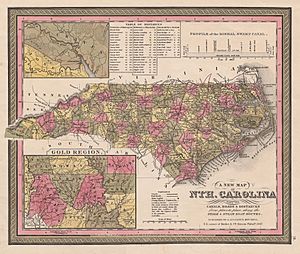Economy of North Carolina facts for kids
North Carolina is a busy state with a strong economy! In 2019, the total value of all goods and services produced in North Carolina was about $591 billion. This makes it one of the wealthiest states in the U.S.
However, there's a big difference in how cities and small towns have grown. Big cities like Charlotte, Raleigh, and Greensboro have grown a lot in the last 30 years. They have more people and more jobs. But many small towns have lost jobs and people. This is because many factories that made things like textiles and furniture moved to other countries where it's cheaper to make goods. This means one out of every five manufacturing jobs in North Carolina has been lost to competition from overseas. When these factories closed, the small towns that depended on them faced tough times.
Did you know that the very first gold nugget found in the U.S. was discovered in Cabarrus County, North Carolina, way back in 1799? Also, the first gold dollar ever made in the U.S. was minted at the Bechtler Mint in Rutherford County.
Contents
Farming and Factories
The North Carolina Department of Agriculture and Consumer Services helps manage farming and manufacturing in the state. For over a hundred years, North Carolina has been a leader in agriculture (farming), financial services (like banking), and manufacturing (making goods).
In the early 1990s, North Carolina was ranked eighth in the nation for its factory output. This included things like textiles (cloth), chemicals, electrical equipment, paper, and wood products. Even though many textile jobs have moved overseas, North Carolina is still the biggest employer in the textile industry in the United States. Recently, another important industry, furniture making, has also seen jobs move to places like China.
North Carolina's farms produce many important things. These include poultry (chickens) and eggs, tobacco, hogs (pigs), milk, nursery plants, cattle, sweet potatoes, cotton, and soybeans. North Carolina is the top producer of tobacco in the country. Tobacco has been important to the state's economy for a very long time.
In the mountain areas, farmers grow sweet corn, wheat, oats, barley, hay, tobacco, fruits, and vegetables. Many cattle and chickens are also raised for sale. A newer industry in the mountains is growing and selling Christmas Trees. In the central part of North Carolina, called the Piedmont region, you can find all the same products as the mountains. But in the southern Piedmont, cotton is a main crop.
In the rich soils of the coastal region, cotton, corn, and oats are important crops. Also, truck farming (growing fruits and vegetables to sell in northern markets) is a thriving business. Long ago, longleaf pine forests in the coastal area were used to make tar, pitch, and turpentine. More recently, they were used for lumber. Today, many areas have been replanted with loblolly pine, which is used for paper pulp, plywood, and lumber. North Carolina is also home to four types of grapes that are native to America: the Catawba, Isabella, Lincoln, and Scuppernong.
Jobs and Work
In 2010, CNBC ranked North Carolina as the fourth-best state in the nation for business. This shows it's a good place for companies to operate. In October 2019, the unemployment rate in North Carolina was 4%. This means that 4% of people who wanted jobs were looking for work.
Energy
Solar Power
North Carolina is becoming a leader in using Solar power, which is energy from the sun. In 2007, the state had very little solar power, but by 2019, it had grown to 6,152 MW (megawatts). This made North Carolina the second-biggest state for solar power in the U.S.
This growth happened because of help from the government. The state has a plan called a Renewable Portfolio Standard. This plan aimed for 12.5% of the state's energy to come from renewable sources by 2021. North Carolina also offered tax credits for renewable energy. Both of these things helped more solar farms get built.
Did you know that North Carolina is also known for something called "solar shepherds"? This is when farmers let sheep graze around solar power plants. The sheep eat the grass, which saves money on trimming it. It's a clever way to combine farming and clean energy!
By June 2019, about 5.81% of North Carolina's electricity came from solar power. The state was ranked second in the country for total installed solar panels.

- Source: NREL
Wind Power
Wind power in North Carolina uses the strong winds found along the coast in the east and in the mountains in the western part of the state. North Carolina also has a lot of wind energy available offshore, meaning out in the ocean. By 2015, many small wind turbine projects were built across the state. In 2016, North Carolina finished its first large wind power project. This was also the first big wind farm in the southeastern United States.
In 2019, North Carolina could produce 208 megawatts of power from wind.Money, Tech, and Research
Charlotte, North Carolina's biggest city, is growing fast. This is largely because of its strong banking and finance industry. Charlotte is the second-largest banking center in the United States, right after New York. It's home to major banks like Bank of America and Truist Financial. The Charlotte area also has six other very large companies listed in the Fortune 500.
In the capital city of Raleigh, you'll find SAS Institute, one of the world's largest private software companies. Also, CaptiveAire Systems, the biggest private company making kitchen ventilation systems, was founded there.
The information and biotechnology industries have been growing steadily since the 1950s. This growth is thanks to the creation of the Research Triangle Park (RTP). RTP is located between the cities of Raleigh, Durham, and Chapel Hill. It's a world-famous research center with over 170 companies and government agencies. It's also the largest and oldest research park in the U.S. The park is close to three major research universities: the University of North Carolina, Duke University, and North Carolina State University. Being so close to these universities has really helped the park grow.

Another big research project is the North Carolina Research Campus in Kannapolis. This campus aims to boost the Charlotte area's economy, much like RTP helped the Raleigh-Durham region. It's a huge project involving Duke University, University of North Carolina at Charlotte, University of North Carolina at Chapel Hill, and N.C. State University, along with private companies. This campus combines business, academic, and living spaces, all focused on research and development (R&D) and biotechnology.
Similarly, the Wake Forest Innovation Quarter in Winston-Salem is another research hub. It works with several universities and specializes in digital media, advanced materials, biomedical science, and information technology. In 2006, University of North Carolina at Greensboro and North Carolina A&T State University teamed up to create the Gateway Research Park. This park focuses on areas like nanotechnology, biotechnology, environmental sciences, and genetics.
Movies and Art
North Carolina is a popular place for making movies and TV shows! Film studios are located in cities like Shelby, Raleigh, Durham, Charlotte, Asheville, Wilmington, and Winston-Salem.
Wilmington is home to EUE Screen Gems Studios. This is the largest TV and film production facility in the U.S. outside of California. Their "Dream Stage 10" is the third-largest sound stage in the country. It also has the biggest special-effects water tank in North America! Since the studio opened in 1984, Wilmington has become a major center for American film and TV. Over 300 productions have been filmed there.
Some well-known movies and TV shows filmed in North Carolina include: Forrest Gump, Bull Durham, Dirty Dancing, The Green Mile, The Last of the Mohicans, One Tree Hill, and The Hunger Games trilogy. In fact, half of the movies based on Stephen King's books were filmed in North Carolina!
The TV show most connected to North Carolina is The Andy Griffith Show. It aired from 1960 to 1968 and was set in the fictional small town of Mayberry, North Carolina. This town was based on the real town of Mount Airy, North Carolina, which is the hometown of actor Andy Griffith. The show is still very popular today in reruns. North Carolina also hosts some of the biggest film festivals in the Southeast. These include the National Black Theatre Festival, RiverRun International Film Festival in Winston-Salem, and the Full Frame Documentary Film Festival in Durham, North Carolina.
Tourism
North Carolina is a great place to visit! People come to enjoy amusement parks, golf, wineries, beautiful beaches, majestic mountains, and exciting sports events. The tourism industry in North Carolina provides jobs for over 190,000 people. The state is the 6th most visited in the country. The North Carolina Department of Commerce helps develop tourism, especially in rural areas.
Taxes
North Carolina has a flat personal income tax rate of 5.75%. The basic state sales tax is 4.25%. Most things you buy will also have a 2.5% local tax from the county, making the total 6.75%. In Mecklenburg County, there's an extra 0.5% local tax for public transportation, bringing the total sales tax there to 7.25%. There are also taxes on gas, cigarettes, wine, and beer. Some counties also add a 1% tax on prepared food.
Property taxes in North Carolina are handled by the counties. These taxes are on real property (like land and buildings), motor vehicles, and some personal property. North Carolina's total state and local tax burden is about 10.5% of income, which is just below the national average.



